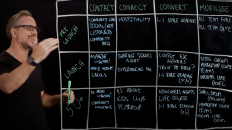See Part 1: Accelerated Change for the context for this post.
Part 3: Some Limits to Creating Community
We should all have an interest in the future of ministry to school leavers/young adults
Not only campus leaders but church leaders, denominational leaders and other parachurch leaders should all care about what is happening in the work of ministering to school leavers/young adults.
This is a pivotal time of life for both maturing Christians and sharing the gospel with non-Christians; it is a crucial demographic in recruiting leaders for church and mission.
If campus ministries are no longer doing as much as we need them to do in their current form in some contexts, we should all care about what we will do to make sure school leavers/young adults are being effectively ministered to, evangelised and challenged for a lifetime of ministry and mission.
So these blog posts are not only for me and my fellow campus missionaries and student leaders, but also for all Christian leaders to engage with. What is the best way that we can all ensure that the work is being down well?
The current Australian campus ministry model is kind of new and kind of old
Campus ministry in hasn’t always been the way it is now in Australia. And it isn’t the only way that campus ministry is being conducted around the world.
The current Australia campus ministry model in AFES is actually kind of new: It was notably pioneered by Phillip Jensen, who started Campus Bible Study, as the Anglican chaplain of UNSW—technically not an AFES group, but now AFES-aligned, if not a formal affiliate. This model was advocated for, strongly, when Andrew Reid was AFES General Secretary in the 1980s and has become increasingly the norm across the country.
The model could be (somewhat unfairly) described as ‘church on campus’ and is marked by the following features:
- Theologically-trained and usually full-time staff assigned to individual campuses. This is different than itinerant, often part-time and not necessarily theologically trained staff working with multiple campuses.
- Regular public Bible preaching and teaching, usually weekly.
- Regular in-depth training in the form of various kinds of workshops and courses.
- Students and others recruited MTS apprentices (or equivalent) both as junior staff on campus and with a view to being recruited for full-time Christian ministry.
- Annual Conferences, often called Mid-Year Conferences, with very in-depth theological teaching in a range of formats.
- Occasional seasons of heightened evangelistic events.
- Often strong emphasis on one-to-one discipleship ministry by staff.
- Often emphasis on various kinds of stranger evangelism: walk-up evangelism, advertising tables, fliering.
This current model is also relatively old now. Phillip Jensen began as Anglican chaplain at UNSW in 1975. That’s nearly fifty years ago. Andrew Reid became General Secretary of AFES in 1984—nearly forty years ago. UTAS adopted this model in 1995, that’s nearly thirty years ago. It’s at least possible that this model has become something of a tradition, and may not necessarily be the best model for the future. For many AFES staff, that means the current model is all they have ever known.
Emotional and intellectual distance to evaluate what’s needed
It’s actually quite hard to think clearly about what is desirable for the future of campus ministry… because many of those involved have strong emotional attachment to various programs and activities, drawing from our own experience as university students and current staff’s sense of satisfaction (or job security) in engaging in various ministries today.
It’s also difficult with something as big as campus ministry, especially in the model described above, to pinpoint which things are central and which things are secondary. Because so many of the activities and programs have value for all sorts of reasons, it can be hard to seriously consider abandoning any of it, because we can justify all of it.
However, some hard, critical and creative thinking, facilitated by some degree of provisional emotional and intellectual distance is needed for us to explore what could be best and most-needed for the future. What is the best use of time, energy and money? Where could we potentially save significant time, energy and money? What things are we aiming for that are no longer possible in quite the same way that used to be so effective? Are there different needs or emphases we need to focus on?
With this in mind, here is a spread of 5 possible models to think about what campus in Australia could or might be. To at least open our minds and hearts to think beyond what we have been used to our entire lifetime.
1. Obsolescence
Parachurches don’t have to last forever. It is at least theoretically possible that there will come a day where there is minimal reason for campus ministries on at least some campuses in Australia. Or it may be that the current campus ministries cannot practically make the changes they would need to make to really justify their existence. Sometimes existing parachurches need to retire to make space for new missions and ministries to potentially emerge.
I’m not personally convinced there is a good case for the obsolescence of campus ministry in Australia. But I do believe that if this possibility cannot even be seriously talked about, that might be an unhealthy sign, a refusal to really think seriously about what is best.
2. Continue with the existing model
Whenever considering strategic options, ‘Do Nothing’ should be one of the options. It could be that the existing model continues to be the best option for now, or at least that we do not think it is wise to make any big changes just yet. Wait and see may still be the wisest course of action.
Within this option, there remains room for lots of minor course-corrections: adjustment of programs and emphasis; reduction of staff team size; merging or collaboration with other campus groups etc.
3. Focus on Public Events and Conferences
Many parachurches in previous generations worked almost entirely on intensives rather than regular weekly meetings. Conventions, conferences, large mission/revival rallies—often paired with a regular newsletter/magazine or other literature, sustained the movement.
Perhaps the full machinery of the existing Australian campus group, overseen by paid staff, is no longer as needed in some contexts and will no longer as able to attract significant number of students to at some universities. It might require increasing effort for decreasing results. Perhaps a more concentrated focus on a few really valuable events will be the way forward?
This approach may also be less attached to an individual university, more regional-based, more focussed on school leavers/young adults as a demographic, rather than enrolled students at a particular tertiary institution. It may also be coupled with a more direct promotional focus on local churches, rather than promoting directly to students through their time on campus.
This model could still run a network of small groups, mentoring, training and other activities underneath it, but that may not be its central focus. And it the expectation of the ministry may not be that the ideal is for all people who benefit from the public events and conferences also lock in to this larger structure.
It seems like such a pity to lose the depth and regularity of weekly sermons on campus. But it’s worth remembering that this is not an essential feature of campus ministry. It is a peculiar feature of the current Australian model, which is kinda new, and kinda old.
4. Small Group Network
The historic IVCF and pre-1986 AFES model was a network of small groups and special events hosted by student leaders and supported by itinerant staff.
I don’t personally see how this model will be one that will lead to more significant growth and effectiveness for campus groups in Australia.. theoretically it could be, but I’m not convinced that this approach would be able to generate the momentum and critical mass to really grow.
Coupled with Model #3, this network approach could run underneath the public events and conferences. But thinking about Model #4 as a distinct model to the existing campus ministry approach to small groups frees us up from assuming the small group network needs to have the same degree of intensive oversight, training and resourcing that currently marks many campus groups.
It could also be that this is just the wisest, good-stewardship approach: there is value to some kind of campus ministry, but not a clear need for something as intensively staffed. It may be that in some places contextual factors mean certain cities or campuses can’t sustain the existing campus ministry model, but rather than opting for obsolescence, a return to a less staff-intensive model might reflect the limited capacity of student ministry in those locations. Surely there’s comes a point where a student group is not of sufficient size to justify a full-time staff member. Perhaps there’s a point where the student group does not need a specially-allocated staff member at all.
5. Consultation/Service Ministry
A final model that campus groups might adopt in a particular city or region is to become a consultation/service ministry, which provides resources and expert staff to work with churches in their efforts to evangelise and traing school leavers/young adults/uni students.
Such a ministry might work with individual churches or whole denominations, providing a way for them to turbo charge their ministry to this demographic. It would be a kind of Department of Evangelism for a specific demographic.
Often churches employ youth leaders part time, but the focus of their work is on school-aged youth—there may not be focussed attention or groups for young adults. Many denominations employ youth specialists to support churches in this area, but often there is less intentional work for young adults. This area of ministry remains a niche that needs investment in, and if campus ministries are not longer effective to the degree that they used to be, something else needs to be discovered to work effectively to this demographic.
What are your thoughts?
I’d love to hear what you are seeing in your context, what you are thinking, what you are trying and what you think of my analysis of the context and options! Best way to interact is to find this post on my
Facebook Page or
Twitter and comment there!


